
THE PAST
HAS A BEGINNING
THE PRESENT

THE EXHIBITION
Since the first portable timepiece was invented in the 16th century, mankind has aspired to perfect the art of timekeeping utilizing emerging technologies, designs and materials to improve accuracy and functionality.
From a fashion accessory for royalties and nobilities, to a scientific instrument in the fields of exploration and research, or a life-saving necessity on the battlefield, the evolution of these instruments has chronicled the history of man.
With this in mind, let us take you on an exploratory journey into the past, appreciate the present and honour what has always been a constant – The Value of Time.
VISIT EXHIBITION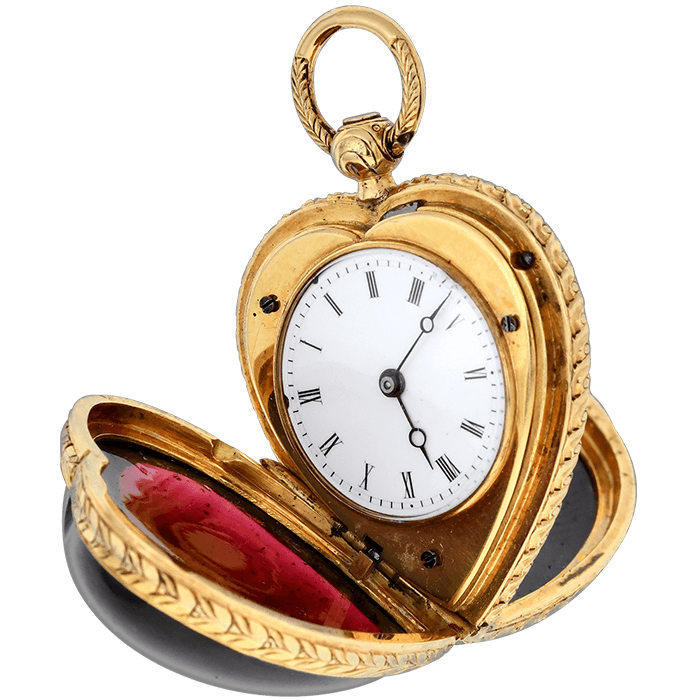
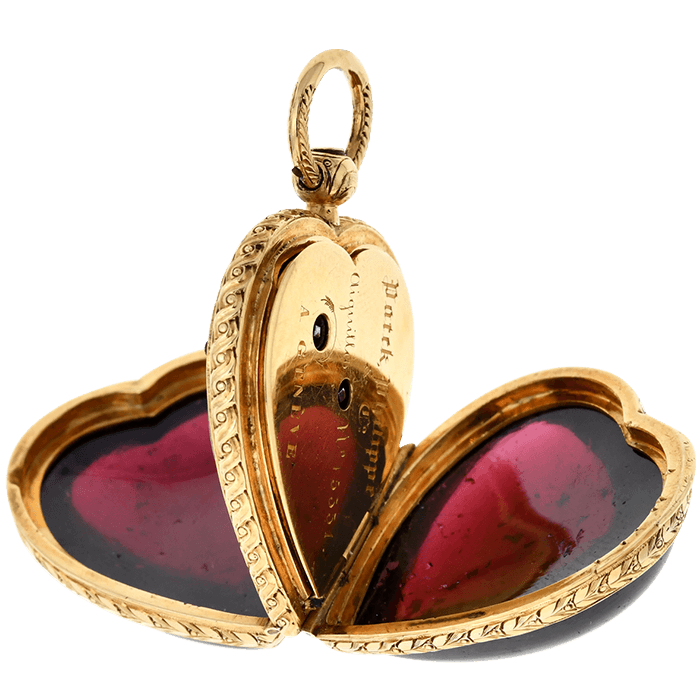
Patek Philippe
The Garnet Heart
Ladies’ watches have been becoming more popular lately and this has resulted in a number of interesting offerings by various watch brands. Making a ladies’ timepiece is more challenging for a watchmaker than a typical men’s one, since the size of the watch would generally be smaller.
With this in mind, and with the added tendency of utilizing ladies timepieces to showcase savoir-faire in jewellery making, this “Garnet Heart” from Patek Philippe is an exceptional example of the brand’s abilities in both the art of watchmaking and jewellery.
On the surface, you will probably think that it is just a heart shaped pendant with an engraved gold band and domed cut Garnet. Yet the secret of this exceptional piece is revealed when you open the covers to reveal a white enamel dial on the front, with black painted roman numerals and flamed blued Breguet hands.
Designed to accompany its lady owner to a dinner party or soiree, the aesthetics of the piece takes prime importance, and with the time needed to be read perhaps infrequently and discreetly, the entire piece measures only 23mm in width and 36mm in height. Opening the rear cover, you can see all the parts of the gear-train plainly visible, with the two main elements; the balance wheel and the mainspring, taking up a lion’s share of the space.
The Garnet Heart demonstrates a very high level of watchmaking given the ingenious space-saving ideas that it incorporates, as well as the precision required to manufacture and assemble the very small components. For example, by conforming the circle of the mainspring barrel (at the top left of the movement) to the curved portion of the heart shaped case.
In this piece, time setting and winding are accomplished via a key that interfaces directly with the movement on the rear side. Also, as typical of dials at the time, there is no signature, however the rear hinged movement cover is signed with the maker “Patek Philippe & Cie”.
There were a total of 30 pieces of this timepiece made between 1853 and 1868, with each carrying a unique and different case decoration as per the wishes of each client. As it stands right now, only nine pieces are known to have survived, with four of these in the Patek Philippe Museum in Geneva, and the rest, including this one made in 1859, in the hands of private collections worldwide.
SPECIFICATIONS
Case:
- Marked PPCo, made in 1859
- Four-piece, engraved band and pendant
- Heart shape domed garnet cut on both sides
- Dia.: 23 x 36mm
Movement:
- Cal. 9’
- Key-wind Cylinder Escapement “Heart” shape
- Made in 1858
Dial:
- White Enamel with black painted Roman markers and minute scale
- Blue flamed steel thin “Breguet” hands
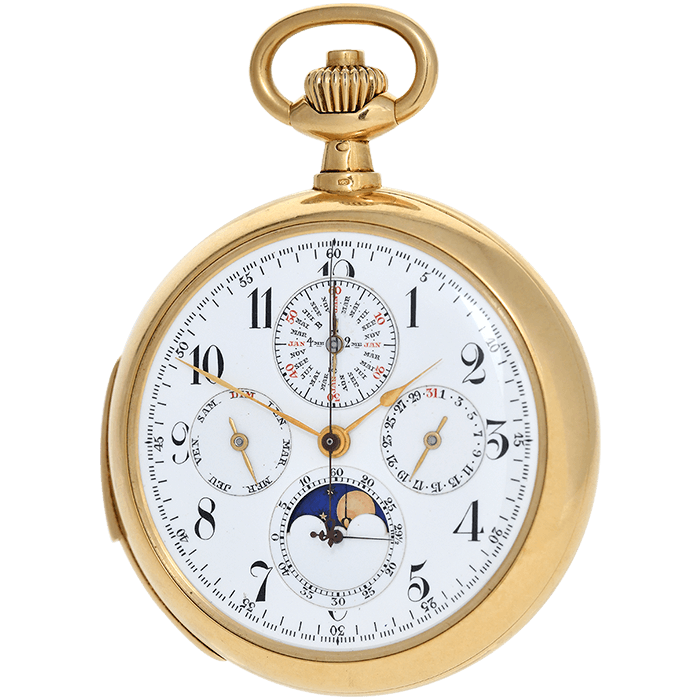
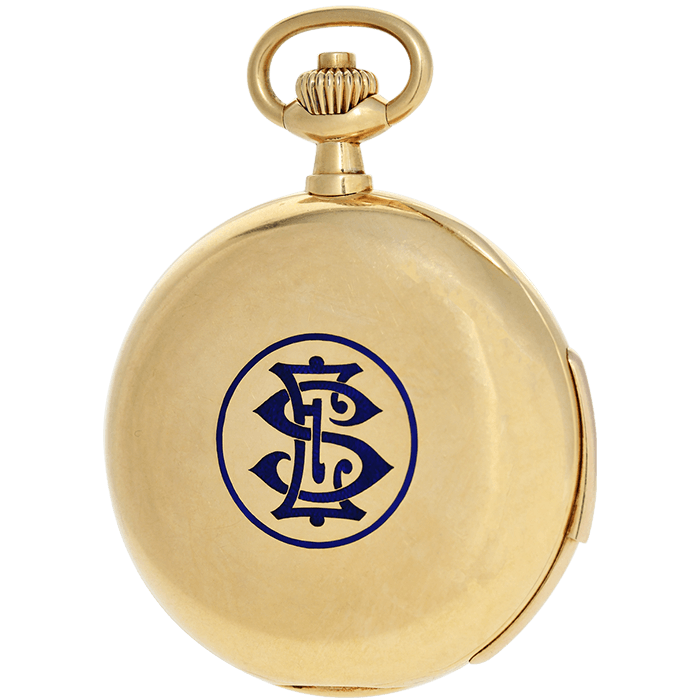
Audemars Piguet
Pièce unique, n° 12585 Grand Complication
Part of the reason why Audemars Piguet is so respected as a brand today comes down to the fact that they have been firmly entrenched at the pinnacle of high watchmaking for a very long time.
This particular pocket watch, a unique piece, no. 12585, which was sold in 1923, is a case in point. It is a grand complication pocket watch containing some of the most challenging complications in watchmaking to execute - such as a chronograph, perpetual calendar, moon phase indication and the minute and quarter repeater. The perpetual calendar complication, an Audemars Piguet signature, which in this pocket watch, forms the basis of the highly evolved modern versions currently.
The piece itself is crafted in 18K gold, with a classic design typified by a white enamel dial, stylized with Arabic numerals for hours and minutes, three auxiliary dials for the indication of the days of the week, date, months and leap years and a central hand for the chronograph complication.
An interesting point about this pocket watch- it was sold in 1923 by the Parisian dealer, Picq et Fils, and was well preserved by the descendants of the original owner, whose initials “ES” are rendered in blue enamel on the rear case cover. This piece shows how well these mechanical treasures can transcend time, being objects of such value and significance that they can be enjoyed generations after they were made.
SPECIFICATIONS
Case:
- Round on Hinge
- Blue Enamel initials of original owner “ES”
- Signed “Audemars Piguet & Cie, No. 12585”
Movement:
- Dia. : 51 mm
- Gross weight: 100.95 g.
- Cal. 18SMCRV
- Mechanical with lever escapement, bi-metallic cut balance, hairspring, strikes with two hammers on a gong, triggering on the caseband for the dual chronograph and minute repeater function, micrometric adjustment
- Period case marked with the initials "ES"
Dial:
- White enamel
- Stylized Arabic numeral hours and minutes
- Three auxiliary dials for indicating days of the week, date, months and leap years
- Central hand for chronograph function & 30-minute counter
- Small second hand with moonphase aperture
- Railroad timer graduated 1 / 5th of a second
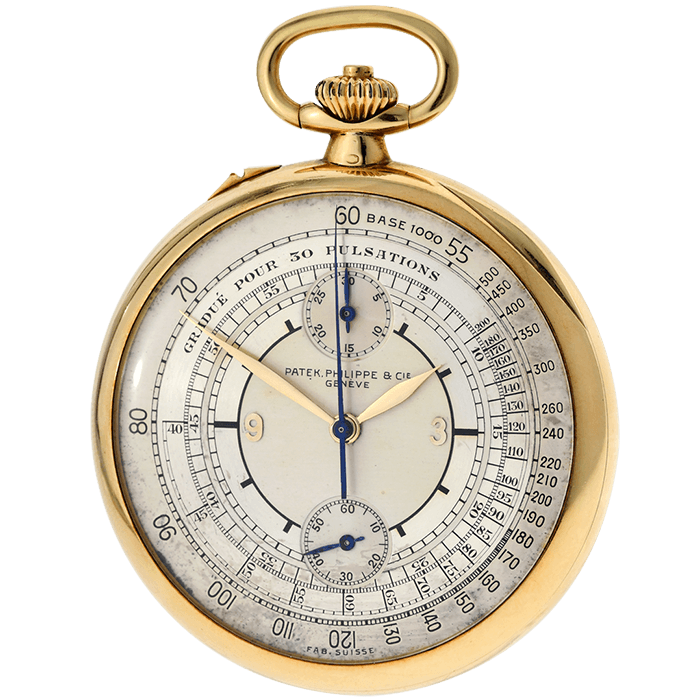
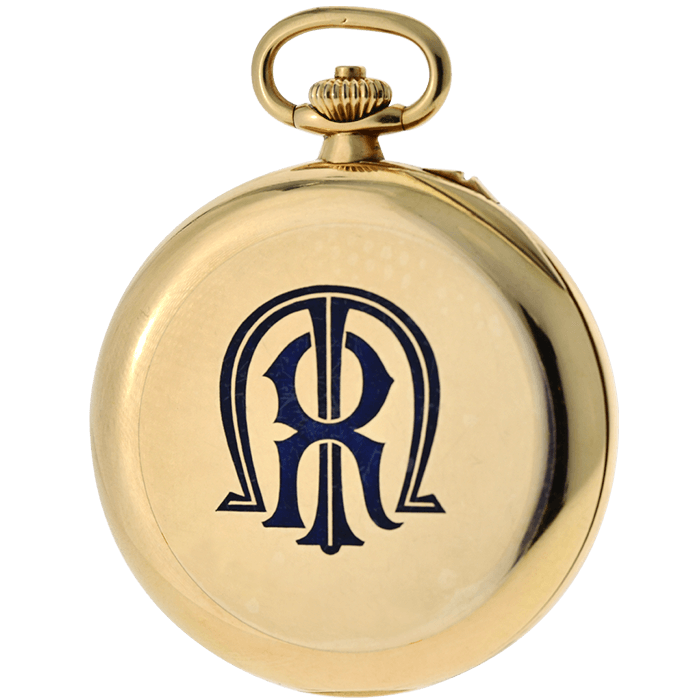
Patek Philippe
Ref. 19 211 Sector Dial
This main complication, aside from the hours, minutes and seconds of this Ref. 19 211 pocket watch from Patek Philippe is that it is a monopusher chronograph. The highly specialised set of features that point to the most likely client of this pocket watch being a medical professional.
Firstly, the main complication is a monopusher chronograph that measures only up to 30 minutes, suggesting that the end user did not require it to measure longer periods of time. Secondly, having only one single pusher to handle the start, stop and reset operations, suggests the need for the end user to be able to use the time measurement functions quickly and probably with only one hand. The final clue makes a further case for this and that is the pulsometer scale. As per the words “Gradué” Pour 30 Pulsations” or "Graduated for 30 beats" in English, it is used in conjunction with the chronograph seconds hand where the user is meant to count up to 30 heart beats of a patient, then stop the chronograph, allowing user to quickly get the patient’s heart rate in beats per minute.
The tachometer scale, which is also used in conjunction with the chronograph measures the speed of a moving object between a set distance. Perhaps, the medical professional owner of the watch, also liked racing fast cars.
It’s rare to have both these two scales together, and the highly elaborate layout and level of detail showing five scales from the outside to the center; speed, medical, fifth of the seconds and seconds, minutes and hours, were all inscribed by the human hands of a highly skilled engraver.
Given that only half a dozen of these watches have been identified so far, with each spotting slightly different dial details, it’s safe to assume that each and every one was customised for the end client.
The complex and elaborate dial was made by famed dial maker "Fabrique de Cadrans Sterns Frères", a business partner of Patek Philippe which ultimately bought over the company during the Great Depression. They are the very same Stern family that are the current custodians of the storied brand today. With this in mind then, it’s hard not to agree that this pocket watch from Patek Philippe, made in 1924 and sold in 1937 is an important witness to this pivotal moment in the brand’s history.
SPECIFICATIONS
Case:
- By Vichet in 1936
- Three-piece “Bassine” shape
- Hinged case back and snapping in bezel
- Dia.: 50,76 mm
Movement:
- Cal. 19”’ CC
- Made in 1924
- Extra Balance
Dial:
- By Stern Frères, multi-tone silver dial
- Silver plate, gold applied 3 & 9 hourmarkers
- Gold “Feuille” hands
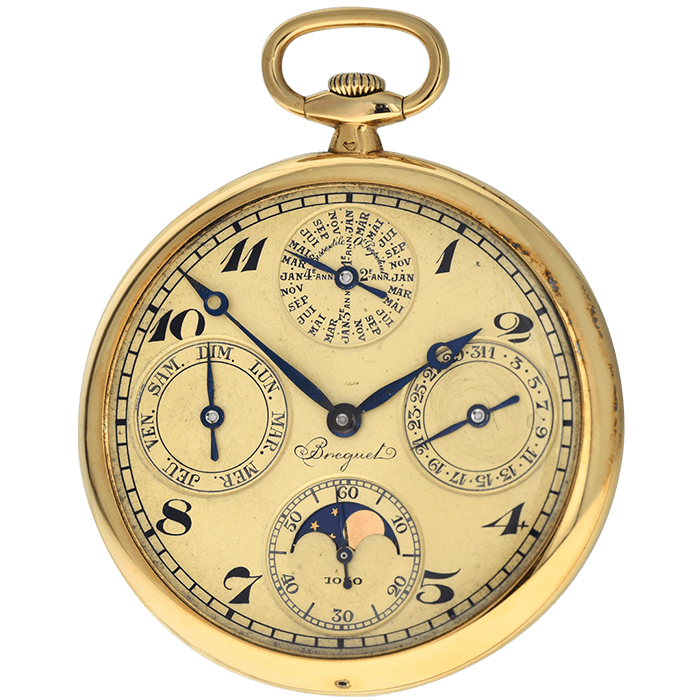
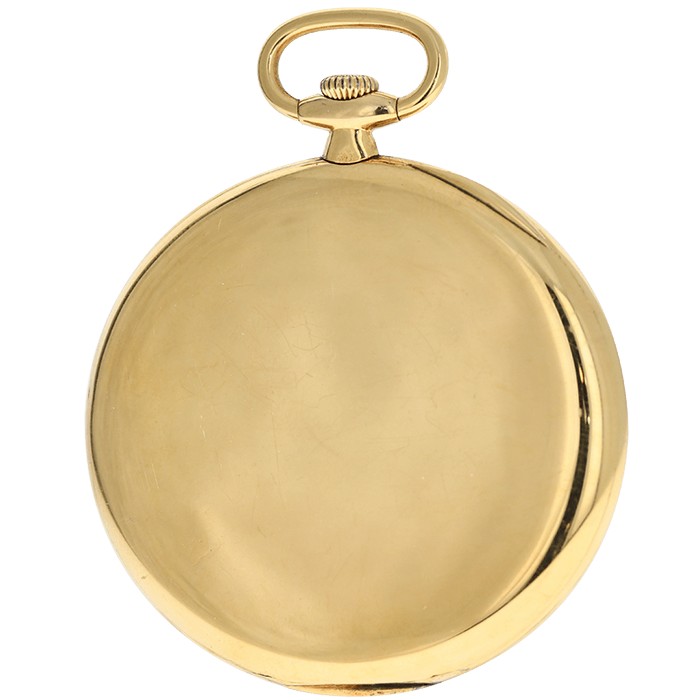
Breguet
N°1 050
Breguet is a brand that you might associate more with the tourbillon, given that it was invented by the brand’s founder, Abraham Louis Breguet in 1801. However, the brand has also made its mark in the realm of the Perpetual Calendar, being the first to manufacture and build a Perpetual Calendar wrist-watch in 1929.
Now it is true that the first Perpetual Calendar wrist-watch ever made was by Patek Philippe in 1925, but it was a movement originally intended for a ladies pocket watch. Therefore, the title can arguably still go to Breguet if we only consider a wristwatch built from the ground up to include the perpetual calendar.
In this context then, the Breguet No.1050 pocket watch can certainly come to represent the brand’s savoir-faire in the realm of high complication, since it also contains a perpetual calendar, as seen from the leap year indication at 12 o’clock. The fact that it was made in 1926 does lend credence to the brand's abilities in coming up with a wrist watch version.
By the early part of the 20th Century, brands such as Audemars Piguet, Vacheron Constantin and Gübelin were focused on making ultra thin movements, partly as a consequence of client demand and partly as a horological boast of capabilities. Breguet was up there with the best of them. Thin perpetual calendar mechanisms and chronograph movements were being designed for ultra thin pocket watch cases with dimensions of 8.5 to 9mm, comparable to modern ultra thin wrist watches.
In the hand, this extremely rare and fine, round shaped, dress pocket watch, in 18K yellow gold is surprising in its density, with its ultra-thin dimensions making a surprising, at first, impression, which gives way to a feeling of satisfaction.
SPECIFICATIONS
Movement:
N'4 494 C/N:1050
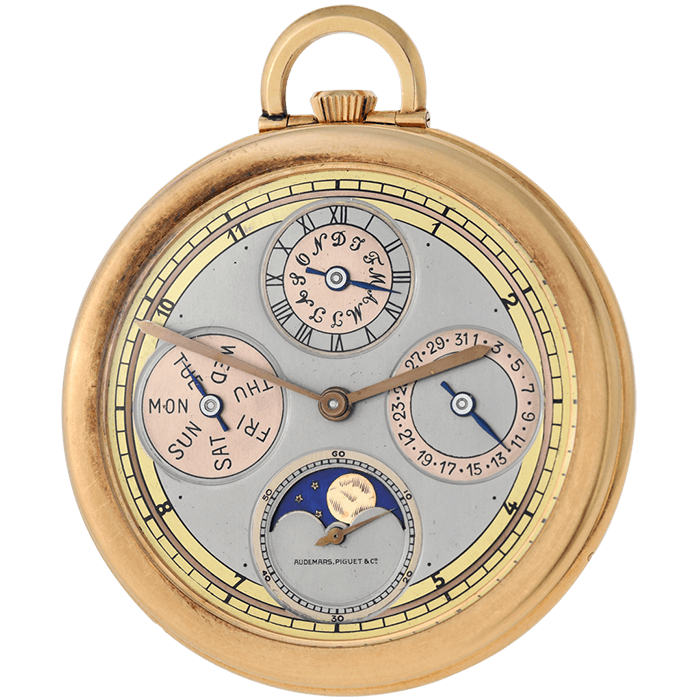
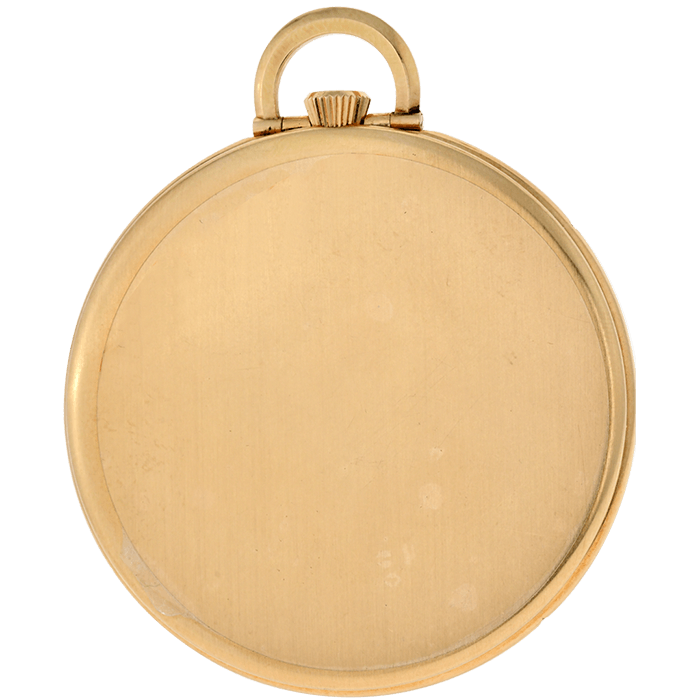
Audemars Piguet
N° 38636 Triple Calendar & Moonphase
The first world record in the realm of the ultra thin timepiece for Audemars Piguet came in the form of a pocket watch movement in 1921. That movement was the Calibre 17SVF#5, which astonished the world with a thickness of only 1.32 mm. While it was a time only movement, it did open the door to other variants that comes with the addition of small seconds, others with a perpetual calendar and Moonphase, and in this N° 38636 Triple Calendar & Moonphase, one will find the Triple Calendar with Moonphase.
How does the complication here differ from a Perpetual Calendar then? Well, a Perpetual Calendar will account for the differing days of the month depending on what month it is, as well as how many days there are in February, which changes depending on whether it is a leap year or not.
A Triple Calendar by contrast, depends on the user to change the indications manually at the end of every month if there are less than 31 days. While this complication may be simpler than a Perpetual Calendar variant, it is, considering the total number of similarly equipped pocket watches made during the 1920's considerably more rare, with only this particular example, turning up at auction over the past 10 years.
This pocket watch also comes in a very richly toned 18K rose gold case, which contrasts nicely with the silver grey tone that makes up the majority of the dial that comes with further rose gold tone accents on the day, date and month sub-dials, as well as a yellow gold tone ring that circles the dial.
It's a presentation that is unusual not just in the colour tones of the piece, but also notably in the 12 o'clock sub-dial, that uses both Roman numerals and letters to denote the month of the year.
It's certainly a one-of-a kind look and adheres in its aesthetics to the era in which it was made - the Art Déco period.
SPECIFICATIONS
Case:
- Round, clipped case-back
- Triple Corrector on caseband
Movement:
- Dia. : 45 mm
- Gross weight: 54.10 g
- Cal. 17SVF # 3 "Côte de Genève" decoration
- Mechanical, bi-metallic balance, balance spring and adjustment racket
Dial:
- Three-tone with Arabic numerals and dot indexes
- Three auxiliary dials for indicating the months (numbers and letters), the date and the days of the week
- Opening for the phases of the moon, small second hand and track timer
- Iron signed
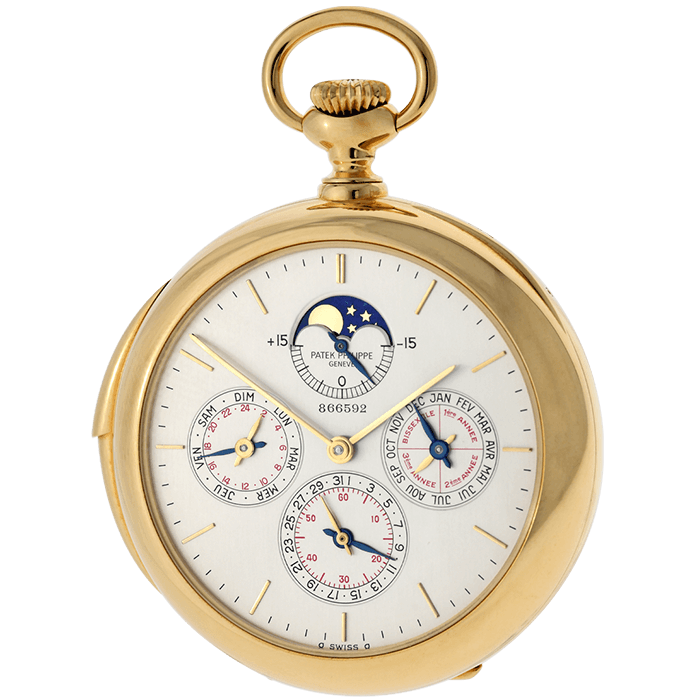
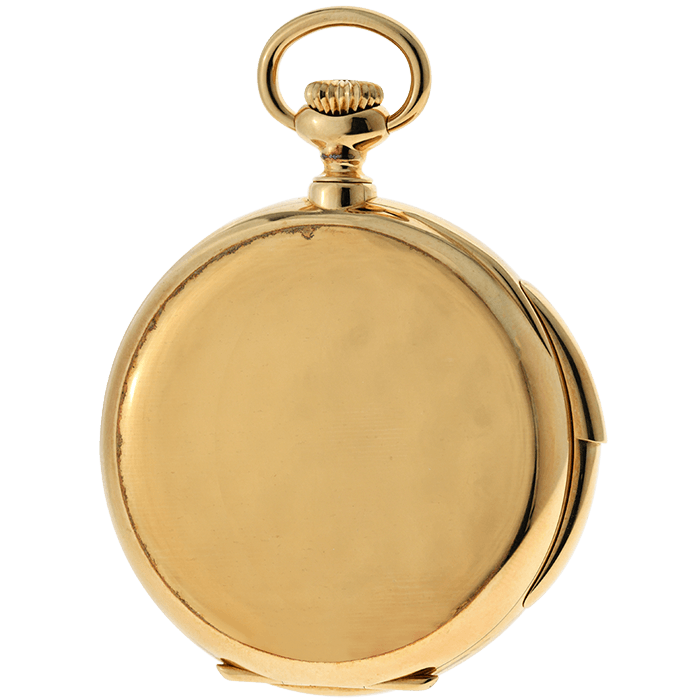
Patek Philippe
Ref 962/1J RQ E Grand Complication
Patek Philippe is one of the rare brands that continues to produce pocket watches even after mechanical wristwatches became the new norm. This makes the fact of this Ref 962-1 being a contemporary pocket watch made in 1992 less of a surprise. In fact it is a variant of the Ref 962 that offers a minute repeater, perpetual calendar, moonphase, leap year indication and 24 hour display, which collectively defined this a Grand Complication pocket watch. Where this Ref 962-1 differs however is with the addition of a unique complication - the equation of time, visible at the 12 o’clock sub-dial.
The equation of time complication is rarely seen across Patek Philippe's offerings, and was invented to account for the differences between clock time and sun-dial time. Ancient man used the sun-dial to tell the time. When mechanical timekeeping was invented, it was realized that the time between the increasingly more accurate mechanical clocks deviated in a set pattern depending on the time of the year to that told by the sun-dial.
It took some time to work out the mathematical relationship, taking into account the elliptical orbit of the earth around the sun, and the tilt of the earth’s rotation with respect to its orbit. The combination of this complex motion would result in a deviation of clock time to sun-dial time, with sun-dial time sometimes being faster, slower or the same as clock time. Consider how difficult it is to translate this into a complication that can be read on a watch dial. The blued steel hand at the 12 o’clock sub-dial points to a position on the dial, reflecting +15 or -15 minutes as the current difference between clock time and sun-dial time.
Aside from the equation of time, the entire dial is well-balanced with two logically grouped hands in each sub-dial, one blued, and one in gold, that point to different indications. Starting from the top and going clockwise, there is the equation of time with moonphase, current month and leap year indicator, running seconds with date, and finally, current day with 24 hour indicator. As with the traditional style, the serial number of the timepiece is printed on the dial.
SPECIFICATIONS
Case:
- By Eggly between 1991-1992
- Four-piece, straight “Bassine” shape
- Hinged back, snapping in display-cuvette and bezel
- Dia.: 52mm
Movement:
- Finished in the 1992 by Dubois Depraz
- Dia.: 38mm
- Cal. 17 QR E, 29 jewels
Dial:
- By Stern Creations
- Gold plate, mat silver silky surface
- Gold applied “Baton” markers and hands

Ali Nael
Founder and CEO,
2ToneVintage Watches
Ali Nael
Founder and CEO,
2ToneVintage Watches
Since I’ve began to collect vintage timepieces, I’ve been driven to seek out and obtain the best possible examples of these pieces of art.
Today, I am living my dream. With the launch of 2ToneVintage Watches in 2018, my passion has transformed into an enjoyable career. Even as the boutique grows steadily towards my business goals, I maintain my belief that it isn’t all about sales performance. As a collector myself, I enjoy those intriguing moments when collectors converge and share their personal collections. It inspires me when like-minded people exchange their passion and admiration over their common interest in horological marvels.
To share my passion for curating vintage timepieces, I launched a book titled My Dream Collection in 2020, showcasing some 128 of the most treasured pieces. Each one of them has a story to tell; a story of human evolution in days gone by.
In light of the challenging times we face today, I reflected on how the world has changed since 2019. Regardless of the hurdles we have to cross before normal life resumes,. As I think back on how we as citizens of the world, and mankind as a whole, have conquered the many challenges history has thrown at us, it’s hard to ignore how timepieces have persisted through the last 600 years of human history, marking every step of our evolution with a time stamp. In the past and in the present, human resilience has stood the test of time. So, as COVID measures ease up in Singapore, I am inspired to launch an exhibition to journey back in time and explore the evolution of watches. The exhibition shall showcase some of the rarest and most important pocket watches from our collection, dating from 1858 to 1995. I present to you The Beginning, and extend a warm invitation to serious collectors, as well as anybody who is interested in collecting vintage timepieces. I look forward to receiving you at our gallery.
Sincerely Yours,
Ali Nael Founder and CEO,
2ToneVintage Watches

Opinions
Maggie Chen
Entrepreneur and Collector
Patek Philippe
The Garnet Heart
Maggie Chen
Entrepreneur and Collector
Patek Philippe
The Garnet Heart
On her choice of featured showcase
“My special affinity with pocket watches started back in my University days. I remember a professor by the name of Patrick N who turns up for lecture every day in a waistcoat and read time from a pocket watch. He always snap the case back with such style and confidence, I got to admit; I was really charmed,” Maggie said as she laughed.
“Resisting mainstream fashion and being comfortable with himself, he manifested a style of antiquity into modern world with charm and confidence. As a fashion student, it meant something,” said Maggie.
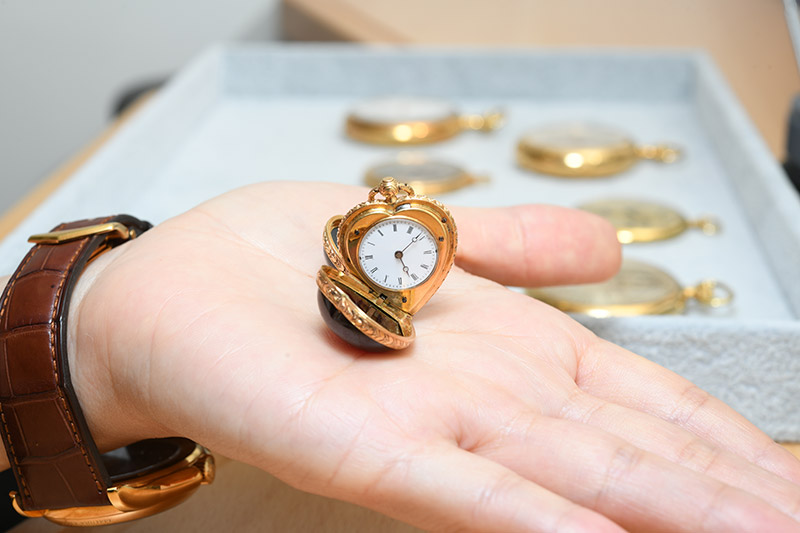
“Soon enough, I too fell for pocket watches! So, whenever I come across pocket watches, I thought of him and my time in the University of Brighton pursuing my dream of becoming a fashion textile designer. Professor Patrick N and pocket watches holds a special place in my heart and memory. Just like this pièce unique Garnet Heart; it’s precious and priceless.”

Opinions
Bernard Cheong
World Renowned Collector & CEO and partner of Lifeline Medical Group
Breguet
N°1 050
Bernard Cheong
World Renowned Collector & CEO and partner of Lifeline Medical Group
Breguet
N°1 050
On his choice of featured showcase
“There’s a tactile appeal to it, hold it and you know it’s true,” he says. “I would describe it as a drop of oil on the tray, if I may,” he chuckled as he put the piece back on the tray.
“The yellow-gold case, the dome on flat back - this is an elegant art piece. The others are of course beautiful but you can see they are quite the standard shape; symmetrical from all sides and thick. I would prefer something flat like this; intricate design with the dial details almost bleeding out of the edge,” said Dr. Bernard with a grin.
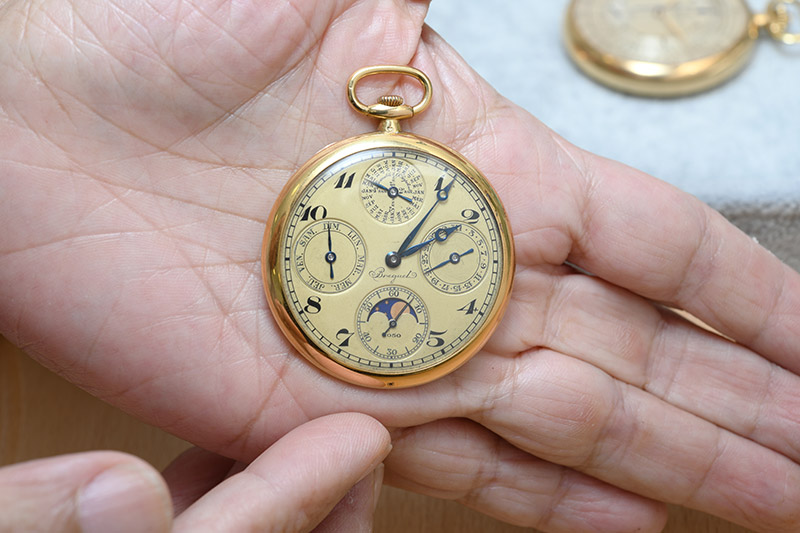
“There’s so much complications and yet Breguet is able to make this so thin. Is it not a trend for things to be minimal and flat today? Think about how intricate this piece is and this is back in the 1920s!”

Opinions
George Tan
Vintage Collector
Patek Philippe
Ref. 19 211 Sector Dial
George Tan
Vintage Collector
Patek Philippe
Ref. 19 211 Sector Dial
On his choice of featured showcase
“I’ve always loved sector dials. Personally, I like things that look very complicated yet organised, call it organized chaos if you’d like.
Sector dials are characterised by the two circles of differing sizes — hours in the inner circle; minutes in the outer circle. Makes reading time very easy.
“This piece is unique as it’s sleek for a sector dial on a chronograph with tachymeter and pulsation measures,” says George as he squints his eye and admires the pocket watch close up under a loupe.
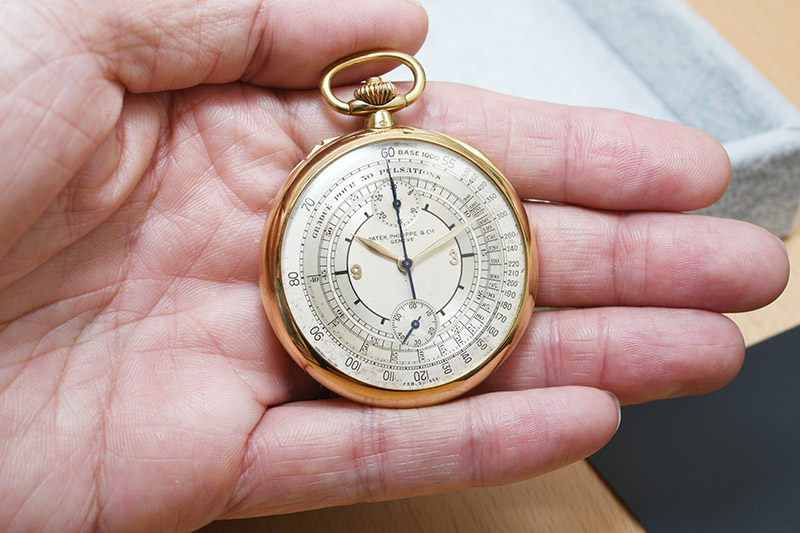
“Many brands launched their own sector dials and one very good example is Longines. They are quite successful with their sector dials in recent years. I believe sector dials is an evergreen trend,” said George.
“At first glance, this piece from Patek Philippe just reeks of the organized chaos that I like. It’s my favourite sector dial and most importantly, it’s testament to the level of sophistication that already existed in those days; a marvel of engineering that batteries shall never replace.”

Opinions
Dharni Ng
Entrepreneur and 2-time Grand Beatbox Battle Champion
Patek Philippe
Ref.962 / IJ RQ E Grand Complication
Dharni Ng
Entrepreneur and 2-time Grand Beatbox Battle Champion
Patek Philippe
Ref.962 / IJ RQ E Grand Complication
On his choice of featured showcase
“When I hear the chimes from this piece during the demonstration, I knew this is for me,” said Dharni with certainty.
“I never knew you can tell time this way through counting the chimes, it’s amazing!” said Dharni, in awe of what he heard when 2ToneVintage demonstrated the Minute Repeater on the Patek Philippe Ref. 962/1 J RQ E Grand Complication.
“Being in the music scene and being sensitive to sound, I’m amazed how engineering of those days can orchestrate such sophistication in such a small frame. Hearing the chimes made me feel like I time-travelled into the past and back again,” added Dharni.
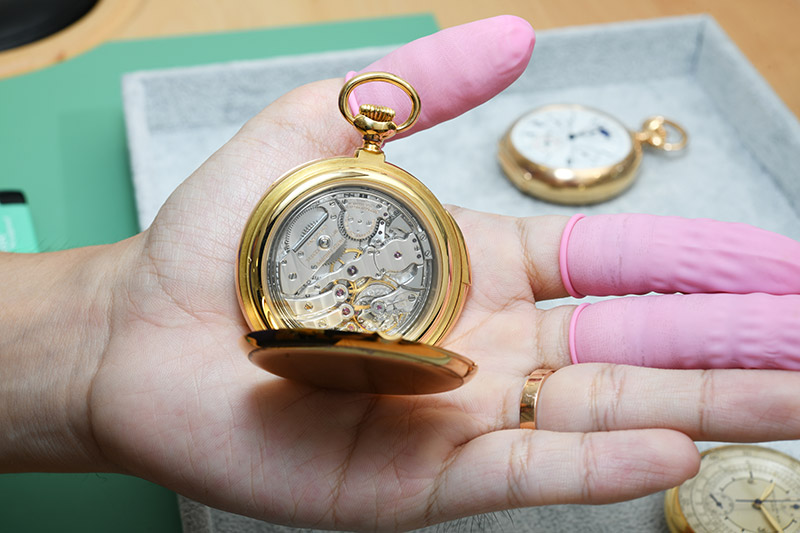
“I’ve always marvelled at how the movements work, with so many small elements tightly packed together to tell us what we simply know as time. Simple as it looks but so much work goes beyond our vision. One may never be a part of it but at least, we can learn to appreciate it.”

Opinions
Nicholas Tan
Collector/Chief Strategy Officer - TaF.tc
Audemars Piguet
Pièce Unique, N° 12585
Nicholas Tan
Collector/Chief Strategy Officer - TaF.tc
Audemars Piguet
Pièce Unique, N° 12585
On his choice of featured showcase
“I have a fair number of contemporaries in my collection but these watches draw inspiration from the past.” said Nicholas.
“I am passionate about watches and as much as possible, I try to search for the rarest and most unique pieces out there. Most of the watches in my collection are somewhat simple in nature, so I chose this model which is a stark contrast to what I collect. The amount of precision that goes into the making of these time machines is not just a marvel but sheer drive for perfection. That’s a spirit I admire” said Nicholas with a big smile.

“When I received the invitation to be part of this even, I feel honoured and I really appreciate the opportunity to be here, thanks!”
Discover The Beginning
Watch lovers & collectors, It brings us great pleasure to have you at our exhibition! Learn about the history of timekeeping and discover the rare and exquisite collection at 2ToneVintage.
To facilitate a comfortable and safe experience for all, we need to schedule and limit the number of visits and visitors to our Gallery. Kindly fill up the form below to book a visit. We will be in-touch shortly.
2ToneVintage Showroom
428 River Valley Rd., #01-11,
Loft@Nathan,
Singapore 248327
t: +65 6977 7123
e: info@2tonevintage.com
w: www.2tonevintage.com
Open from 12pm to 9pm
Monday to Saturday